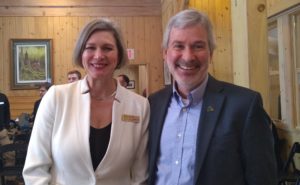Conservation authorities in a unique position to rebuild watershed resilience

Gary Christie of the Nottawasaga Steelheaders and Jack Imhof of Trout Unlimited Canada at Friday’s annual general meeting of the Nottawasaga Valley Conservation Authority. -AWARE Simcoe photo
By Kate Harries AWARE News Network
In a keynote address to the Nottawasaga Valley Conservation Authority, watershed scientist Jack Imhof stressed the importance of planning that stretches across an entire watershed.
A failure to manage our natural infrastructure will strongly challenge our built infrastructure, Imhof told
 NVCA directors and the many politicians and invited guests on hand to honour the authority’s 60th anniversary this year.
NVCA directors and the many politicians and invited guests on hand to honour the authority’s 60th anniversary this year.
‘Protect the best and restore the rest’ was the title of Imhof’s presentation. All too often, he said, the motto is taken as ‘protect the best and ignore the rest.’ But there’s a lot more of ‘the rest’ than ‘the best.’
Collingwood Councillor Mariane McLeod is the new vice-chair of the Nottawasaga Valley Conservation Authority and Essa Councillor Keith White steps up from vice-chair to chair. -AWARE Simcoe photo
Imhof presentation to NVCA- AGM
We all have an interest in rebuilding resilience, said Imhof, a retired aquatic ecologist and watershed research scientist with the Ontario natural resources ministry and national biologist with Trout Unlimited Canada.
It’s about much more than minimizing negative impacts.
It’s about more than restoration which aims to return a landscape to its pre-settlement condition and function.
It embraces rehabilitation, which involves the “modification of an existing ecosystem to restore healthy function and dynamic stability.”
That’s integrated watershed management, a concept that’s extensive in its scope. The Nottawasaga watershed stretches from Shelburne to Barrie to the Blue Mountains, encompassing three counties (Dufferin, Grey and Simcoe) and 18 municipalities.
Sounds complicated? It is. Because nature is complicated. And we still don’t know all the consequences of our messing around with drainage and tree clearing and aggregate removal and paving over. But we do know that harm has resulted and people (not to mention other species) have suffered from just demanding too much of our natural infrastructure – with consequences like flooding, water contamination, weather extremes and fire.
Imhof had many examples of situations where simple changes – narrowing watercourses, removing dams, replanting shorelines and riverbanks – have had dramatic results, demonstrating that, given a chance, nature will do its own work. One such effort involved the Beeton Creek in New Tecumseth, where rainbow trout returned by themselves within months of a rehabilitation project.
Emphasizing the interconnectedness of a watershed, Imhof noted that the effectiveness of a site-specific decision is limited.
“If we only fix what we perceive to be the problem at the site, we may not really fix anything,” he said.
Conservation authorities can bring much-needed watershed-wide context to decision-making, by providing data and expertise on a wide variety of issues – from forest management to biodiversity to erosion control to farm fertility to groundwater / surface water interactions, and the list goes on.
In fact, “conservation authorities are in a unique position to create management context and work with municipalities to rebuild resilience in our watershed,” he said.
Imhof’s presentation, cutting to the core of current controversy over the role of conservation authorities, came at the end of a difficult year.
In August, Ontario Environment Minister Jeff Yurek sent what has become a notorious “to who it may concern” letter to authorities across the province, indicating they were engaged in activities beyond the scope of their mandate and he was looking for change.
While many member municipal councils rallied to the defence of the NVCA, some aligned in support of Yurek.
Among the latter were Springwater and Wasaga Beach. NVCA chair George Watson, a Wasaga Beach councillor, came under fire for signing on to a resolution from his council that called for the dissolution of the NVCA. There were calls for his resignation, but he refused.
On Friday, Essa Councillor and NVCA Vice-Chair Keith White was acclaimed as chair for the coming year. Incumbent Deputy-Chair Donna Jebb of New Tecumseth was challenged by Mariane McLeod of Collingwood, who vowed: “I will relentlessly advocate for the existence of conservation authorities in general and the NVCA in particular.” McLeod was elected.









Leave a Reply